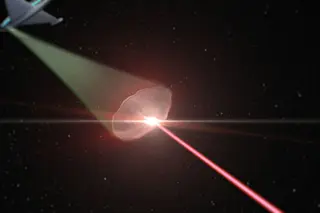A plane-based laser system generates an atmospheric shield to protect itself against a laser attack in this illustration. (Credit: BAE Systems) Lasers could turn Earth's atmosphere into a defensive, or offensive, tool in the future of warfare. Proposed by BAE Systems, a defense and aerospace company founded in the United Kingdom, the conceptual Laser Developed Atmospheric Lens (LDAL) would use lasers to ionize and heat the atmosphere in a way that temporarily endows small pockets of it with useful characteristics. This could take the form of an aerial lens used to magnify objects far away, or even a kind of refractive shield to scatter incoming enemy laser beams.
The concept is essentially the same as using a conventional lens made of glass or plastic. By altering the shape of the lens, light can be focused to a point, or scattered outward and diffused. The LDAL is a theoretical next step, ...














